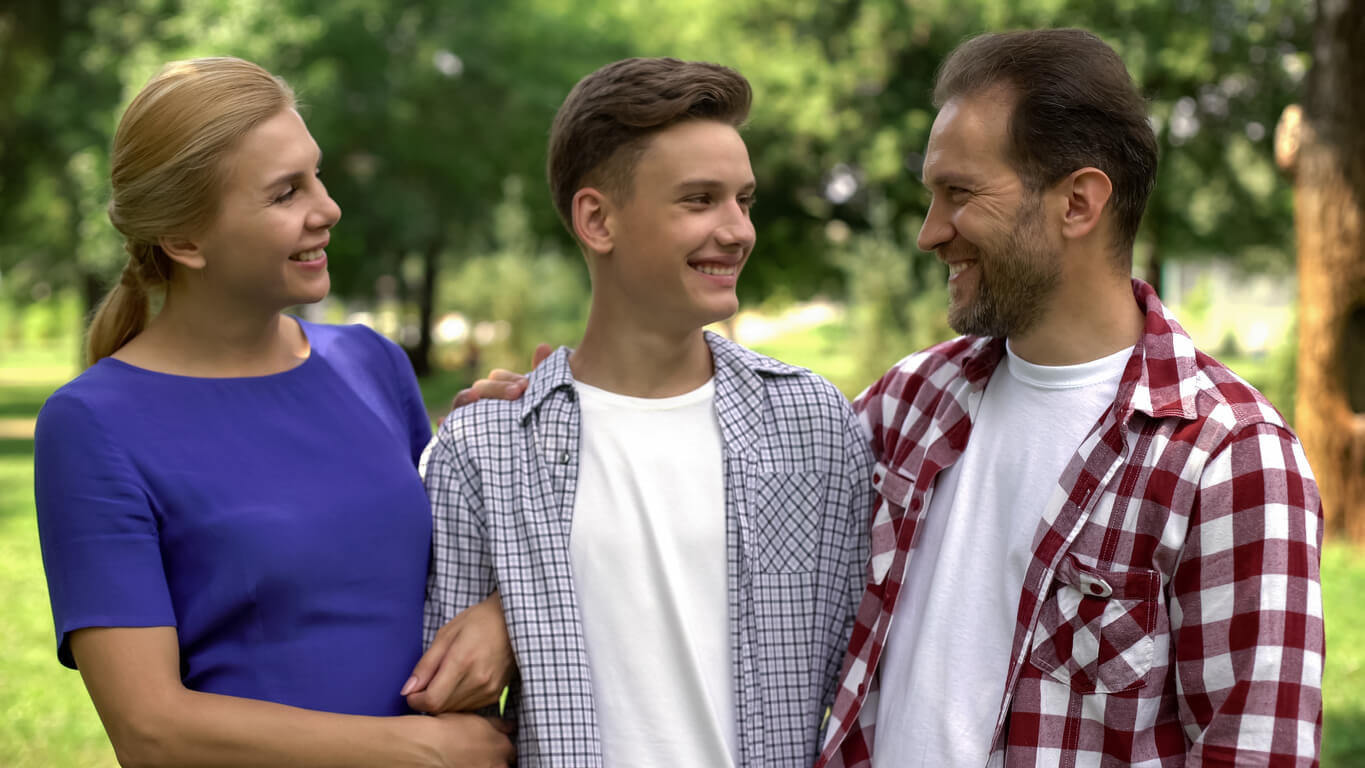7 Keys to Encourage Responsibility in Adolescents


Written and verified by the psychologist Maria Fátima Seppi Vinuales
Encouraging responsibility in adolescents can be a challenge. It’s a stage in which many rules are questioned along the path that young people travel when seeking to discover their identity. However, knowing some keys can help make the path easier.
Discover these keys to working on responsibility in adolescents
It’s worth noting that responsibility is a value that should be put into practice from an early age. In other words, we must always consider what children are capable of doing and make demands of them according to their ability to comply. Otherwise, when we demand too much, we run the risk of frustrating them and making them feel bad for not being able to respond. At the same time, if we demand less, we underestimate their abilities and there’s no challenge that motivates them to excel.
Here are some recommendations to encourage responsibility in adolescents.
1. Establish rules
Responsibility and clarity go hand in hand. Therefore, it’s important that we communicate to young people which rules are non-negotiable and that we agree with them on some others. It’s also important to warn them of the consequences of not complying with what has been agreed upon.
2. Maintain a certain order and discipline
Suggesting a routine that allows foreseeing certain times helps youngsters to organize themselves and learn to cope. Teaching responsibility in adolescents implies being able to recognize the extent to which they’re capable of complying. For example, we can also teach them not to commit to too many activities or sports to avoid overload and stress.

3. Associate responsibility with benefits
This is also a way to make them see that their compliance isn’t related to our own selfish desires, but to their well-being. For example, if they study for exams during the school year, they’ll later be able to enjoy a vacation with their friends.
4. Give them time and space to do what you ask them to do
Many times, we fall into the temptation to perform certain tasks by ourselves because we don’t have the patience to wait for them to solve them. In these cases, what we should do is assign them tasks and give them a deadline to accomplish them. For example, you can say “Friday we’ll go to the supermarket. I need you to write down what you need on a list before then.”
5. Recognize when they behave as expected
Many times, adults tend to point out only the mistakes, as correct behaviors should be normal or expected. However, it’s also good to point out when young people fulfill their commitments. Undoubtedly, this will motivate them to continue on that path.
6. Show consistency in your actions and words
Being consistent with what we say and do is another way of exercising responsibility. If kids make a mistake, we must be able to keep our word. In this case, applying the consequences shouldn’t depend on our mood that day (“I won’t say anything because I want to avoid the problem”), but on what’s already been discussed and agreed upon by all. Otherwise, our word loses value.
7. Be an example
Responsibility is also learned through role models. As adults, we can show them how to practice this virtue by honoring our own commitments and obligations. For example, respecting schedules, letting people know if we won’t be able to attend, and fulfilling our agreements, among other things.
At the same time, it’s also important to practice parental co-responsibility. In other words, the adults in charge must be able to share household tasks so that the children learn on the basis of equitable and collaborative models.
You may be interested in: Co-Responsibility in Parenting

Responsibility and autonomy in adolescence
This topic deserves a special section, as adolescence is a turning point in people’s lives. It’s a stage in which children seek their own place in the world, while at the same time living with a certain disorientation and a whirlwind of changes.
In this regard, although the rules of coexistence must be clear, they must also be sufficiently flexible. More permissions can be granted, margins can be adjusted, and experimentation can be allowed. Depending on the extent to which they do their part, we’ll be able to trust and allow them more freedom.
Finally, we must know that responsibility in adolescents is a daily exercise. Adolescence is a period where young people are in search of their identity. Therefore, challenging some rules is a way of testing themselves.
You may be interested in: 11 Attitudes to Avoid with Your Teenager
Responsibility, a daily test
Fostering responsibility in adolescence isn’t only about doing homework or promoting good coexistence. It’s about developing a skill that’s essential for functioning in society. This is visible in simple, everyday actions such as returning what we borrow, sticking to a schedule, or giving notice if we can’t fulfill a commitment. So, it’s important to help our teens understand that everything involves a certain amount of “give and take”.
Encouraging responsibility in adolescents can be a challenge. It’s a stage in which many rules are questioned along the path that young people travel when seeking to discover their identity. However, knowing some keys can help make the path easier.
Discover these keys to working on responsibility in adolescents
It’s worth noting that responsibility is a value that should be put into practice from an early age. In other words, we must always consider what children are capable of doing and make demands of them according to their ability to comply. Otherwise, when we demand too much, we run the risk of frustrating them and making them feel bad for not being able to respond. At the same time, if we demand less, we underestimate their abilities and there’s no challenge that motivates them to excel.
Here are some recommendations to encourage responsibility in adolescents.
1. Establish rules
Responsibility and clarity go hand in hand. Therefore, it’s important that we communicate to young people which rules are non-negotiable and that we agree with them on some others. It’s also important to warn them of the consequences of not complying with what has been agreed upon.
2. Maintain a certain order and discipline
Suggesting a routine that allows foreseeing certain times helps youngsters to organize themselves and learn to cope. Teaching responsibility in adolescents implies being able to recognize the extent to which they’re capable of complying. For example, we can also teach them not to commit to too many activities or sports to avoid overload and stress.

3. Associate responsibility with benefits
This is also a way to make them see that their compliance isn’t related to our own selfish desires, but to their well-being. For example, if they study for exams during the school year, they’ll later be able to enjoy a vacation with their friends.
4. Give them time and space to do what you ask them to do
Many times, we fall into the temptation to perform certain tasks by ourselves because we don’t have the patience to wait for them to solve them. In these cases, what we should do is assign them tasks and give them a deadline to accomplish them. For example, you can say “Friday we’ll go to the supermarket. I need you to write down what you need on a list before then.”
5. Recognize when they behave as expected
Many times, adults tend to point out only the mistakes, as correct behaviors should be normal or expected. However, it’s also good to point out when young people fulfill their commitments. Undoubtedly, this will motivate them to continue on that path.
6. Show consistency in your actions and words
Being consistent with what we say and do is another way of exercising responsibility. If kids make a mistake, we must be able to keep our word. In this case, applying the consequences shouldn’t depend on our mood that day (“I won’t say anything because I want to avoid the problem”), but on what’s already been discussed and agreed upon by all. Otherwise, our word loses value.
7. Be an example
Responsibility is also learned through role models. As adults, we can show them how to practice this virtue by honoring our own commitments and obligations. For example, respecting schedules, letting people know if we won’t be able to attend, and fulfilling our agreements, among other things.
At the same time, it’s also important to practice parental co-responsibility. In other words, the adults in charge must be able to share household tasks so that the children learn on the basis of equitable and collaborative models.
You may be interested in: Co-Responsibility in Parenting

Responsibility and autonomy in adolescence
This topic deserves a special section, as adolescence is a turning point in people’s lives. It’s a stage in which children seek their own place in the world, while at the same time living with a certain disorientation and a whirlwind of changes.
In this regard, although the rules of coexistence must be clear, they must also be sufficiently flexible. More permissions can be granted, margins can be adjusted, and experimentation can be allowed. Depending on the extent to which they do their part, we’ll be able to trust and allow them more freedom.
Finally, we must know that responsibility in adolescents is a daily exercise. Adolescence is a period where young people are in search of their identity. Therefore, challenging some rules is a way of testing themselves.
You may be interested in: 11 Attitudes to Avoid with Your Teenager
Responsibility, a daily test
Fostering responsibility in adolescence isn’t only about doing homework or promoting good coexistence. It’s about developing a skill that’s essential for functioning in society. This is visible in simple, everyday actions such as returning what we borrow, sticking to a schedule, or giving notice if we can’t fulfill a commitment. So, it’s important to help our teens understand that everything involves a certain amount of “give and take”.
All cited sources were thoroughly reviewed by our team to ensure their quality, reliability, currency, and validity. The bibliography of this article was considered reliable and of academic or scientific accuracy.
- Escarti, Amparo & Sanmartín, Melchor & Pascual, Carmina & Marín Suelves, Diana & Martinez-Taboada, Cristina & Flores, Yadira. (2006). Enseñando responsabilidad personal y social a un grupo de adolescentes de riesgo: Un estudio observacional. Revista de educación, ISSN 0034-8082, Nº 341, 2006 (Ejemplar dedicado a: La cualificación profesional básica: competencias para la inclusión sociolaboral de jóvenes), pags. 373-396. 341.
- Rivera, N., & Lissi, M. R. (2004). La Responsabilidad Social: Cómo la Viven Tres Grupos deEstudiantes de Enseñanza Media en Chile. Psykhe, 13(2),117-130.[fecha de Consulta 12 de Marzo de 2023]. ISSN: 0717-0297. Recuperado de: https://www.redalyc.org/articulo.oa?id=96713209
- Lillo Espinosa, José Luis. (2004). Crecimiento y comportamiento en la adolescencia. Revista de la Asociación Española de Neuropsiquiatría, (90), 57-71. Recuperado en 13 de marzo de 2023, de http://scielo.isciii.es/scielo.php?script=sci_arttext&pid=S0211-57352004000200005&lng=es&tlng=es.
This text is provided for informational purposes only and does not replace consultation with a professional. If in doubt, consult your specialist.








